Abstract
Stress can cause cardiovascular alterations and maladaptive reactions. Stress management techniques such as controlled breathing could be helpful to decrease the physiological alterations caused by prolonged stress levels. With the use of transfer entropy (TE), we can assess the interactions between the cardiovascular and cerebral systems and assess whether these interactions are affected by the application of controlled breathing. In this study, a test protocol was conducted consisting of the stages of rest, first cognitive task (mental arithmetic + Stroop), controlled breathing, second cognitive task (mental arithmetic + Stroop), and recovery. The goal was to evaluate changes in TE between maneuvers in 17 healthy volunteers. The results showed that most interactions were from brain to heart in both cognitive tasks and that the sympathetic pathway was the most affected. In addition, a higher number of significant interactions from the heart to the brain in the second cognitive task after applying controlled breathing, specifically from the vagal part. This suggests that controlled breathing is indeed influencing task, but further training in the breathing technique is needed to find possible significant differences between the tasks.
Access this chapter
Tax calculation will be finalised at checkout
Purchases are for personal use only
Similar content being viewed by others
References
Chu, B., Marwaha, K., Sanvictores, T.: Physiology, Stress Reaction. StatPearls Publishing, Tampa (2022)
Huang, C.-J.: Cardiovascular reactivity, stress, and physical activity. Front. Physiol. 4, 314 (2013)
Burrage, E.: Cerebrovascular dysfunction with stress and depression. Brain Circ. 4, 43–53 (2018)
Ma, X.: The effect of diaphragmatic breathing on attention, negative affect and stress in healthy adults. Front. Psychol. 8, 874 (2017)
Sutarto, A.P.: Resonant breathing biofeedback training for stress reduction among manufacturing operators. Int. J. Occup. Saf. Ergon. 18, 549–561 (2012)
Wang, X.: Cerebral and neural regulation of cardiovascular activity during mental stress. Biomed. Eng. OnLine 15, 160 (2016)
Subhani, A.R.: Difference in brain dynamics during arithmetic task performed in stress and control conditions. In IEEE EMBS Conference on Biomedical Engineering and Sciences (IECBES) 2016, pp. 695–698. IEEE (2016)
Lizier, J.T.: Local information transfer as a spatiotemporal filter for complex systems. Phys. Rev. E Stat. Nonlin. Soft Matter Phys. 77, 1–11 (2008)
Zanetti, M.: Information dynamics of the brain, cardiovascular and respiratory network during different levels of mental stress. Entropy 21, 275 (2019)
Keshmiri, S.: Stress changes the resting-state cortical flow of information from distributed to frontally directed patterns. Biology 9, 236 (2020)
Mueller, V.: The stroop competition: a social-evaluative stroop test for acute stress induction. In: IEEE-EMBS International Conference on Biomedical and Health Informatics (BHI), pp. 1–4 (2022)
Wang, J.: Perfusion functional MRI reveals cerebral blood flow pattern under psychological stress. Proc. Natl. Acad. Sci. U. S. A. 102, 17804–17809 (2005)
Rojas Sánchez, D.L.: Evaluación de la Respuesta Cardíaca y Cerebral ante Estímulos Estresantes Cognitivos y su Regulación con Biofeedback. Undergraduate thesis, Universidad Autónoma de San Luis Potosí, San Luis Potosí, S.L.P. (2018)
Pan, J., Tompkins, W.J.: A real-time QRS detection algorithm. IEEE Trans. Biomed. Eng. 32, 230–236 (1985)
Wessel, N.: Nonlinear analysis of complex phenomena in cardiological data. Herzschrittmachertherapie Elektrophysiologie 11, 159–173 (2000)
Gabard-Durnam, L.J.: The Harvard Automated Processing Pipeline for Electroencephalography (HAPPE): standardized processing software for developmental and high-artifact data. Front. Neurosci. 12, 97 (2018)
Torres, M.E.: A complete ensemble empirical mode decomposition with adaptive noise. In: IEEE International Conference on Acoustics, Speech and Signal Processing (ICASSP) 2011, pp. 4144–4147. IEEE (2011)
Catrambone, V.: Functional brain-heart interplay extends to the multifractal domain. Philos. Trans. A Math. Phys. Eng. Sci. 379, 1–16 (2021)
Lindner, M.: TRENTOOL: a Matlab open source toolbox to analyse information flow in time series data with transfer entropy. BMC Neurosci. 12, 119 (2011)
Kennel, M.B.: Determining embedding dimension for phase-space reconstruction using a geometrical construction. Phys. Rev. At. Mol. Opt. Phys. 45, 3403–3411 (1992)
Wallot, S.: Calculation of Average Mutual Information (AMI) and False-Nearest Neighbors (FNN) for the estimation of embedding parameters of multidimensional time series in Matlab. Front. Psychol. 9, 1–10 (2018)
Lee, J.: Transfer entropy estimation and directional coupling change detection in biomedical time series. Biomed. Eng. OnLine 11, 19 (2012)
Lancaster, G.: Surrogate data for hypothesis testing of physical systems. Phys. Rep. 748, 1–60 (2018)
Komori, T.: Extreme prolongation of expiration breathing: effects on electroencephalogram and autonomic nervous function. Ment. Illn. 10, 7881 (2018)
Birdee, G., et al.: Slow breathing for reducing stress: the effect of extending exhale, Complement. Ther. Med. 73, 1–21 (2023)
Author information
Authors and Affiliations
Corresponding author
Editor information
Editors and Affiliations
Rights and permissions
Copyright information
© 2024 The Author(s), under exclusive license to Springer Nature Switzerland AG
About this paper
Cite this paper
Martínez-Hernández, V.J., Dorantes-Méndez, G. (2024). Analysis of Cardiovascular and Cerebral Interactions in Response to Cognitive Stressors Stimulus. In: Flores Cuautle, J.d.J.A., et al. XLVI Mexican Conference on Biomedical Engineering. CNIB 2023. IFMBE Proceedings, vol 96. Springer, Cham. https://doi.org/10.1007/978-3-031-46933-6_31
Download citation
DOI: https://doi.org/10.1007/978-3-031-46933-6_31
Published:
Publisher Name: Springer, Cham
Print ISBN: 978-3-031-46932-9
Online ISBN: 978-3-031-46933-6
eBook Packages: EngineeringEngineering (R0)




